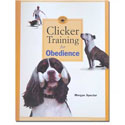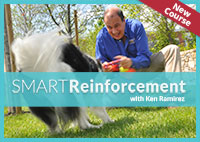Operant conditioning, unconditionally
From Chapter 3 of Clicker Training for Obedience.
Many trainers who dip their toes into the waters of operant conditioning still reserve for themselves the option of "making" the dog do an exercise at some point in the training process. The theory, expressed in different ways, boils down to the notion that "the dog must know that it doesn't have any choice but to obey when I give a command." In response, I pose two questions:
1. Are you, yourself, more likely to do something you want to do, or something that you have to do? (Bet your dog would give the same answer.)
2. If you are doing something you want to do, instead of something you have to do, are you more or less likely to be motivated and enthusiastic about doing it? (Bet your dog would give you the same answer there as well.)
Operant conditioning works on the principle that the dog does what you want because the dog learns that by doing so the dog will get what the dog wants. The dog comes to want to do what you want it to do. Reliability is almost "built in," if the training is done properly.
The dog always has a choice
Anyone who thinks they can avoid "choice" on the dog's part is deluding himself. What is the delusion? It is the belief that negative reinforcement ("compulsion") can eliminate choice. Remember the "ringwise" dog? If a dog truly refuses to perform an exercise in the ring, you are seeing avoidance. "You can't make me do it here, so I won't do it." That's choice, like it or not.
We've all seen dogs that have made this choice. They get their DC (Companion Dog, an AKC title) and are too burned out to go on for their CDX (Companion Dog Excellent) or UD (Utility Dog.) Traditional instructors training competition students avoid these dogs because they perceive their likelihood of ever doing very well as being low. The dogs are castigated as not being a "good obedience breed" or having low "drive" of one sort or another, or being stubborn, of simply too stupid to learn. But more often than not, the truth is far simpler—the dog has not found obedience work to be reinforcing, so he has "opted out." The problem is in the training method, not in the dog.
There are top competitors who search high and low for the "right" puppy. What they want is a dog that won't buckle under stress and punishment. Compulsion creates a dog that works out of fear of force, rather than a dog that works in active partnership. To quote scientist Murray Sidman, author of Coercion and its Fallout, "negative reinforcement, particularly if intense and continuous, can narrowly restrict our interests, even causing a kind of tunnel vision that keeps us from attending to anything except the stress we are currently being subjected to. We may handle set routines very well, although perhaps in a stereotyped, mechanical, or compulsive fashion."
Sound familiar? This is the so-called "pattern-trained" dog, a dog that does it all well so long as the pattern is not disrupted. But when called upon to solve a problem or respond to the unexpected, the normally "reliable" behaviors fall apart. What's worse, the dog does not have the resources to work through the unexpected problem. Why? Because the dog has been conditioned to passivity in the face of uncertainty. For this dog, it is better not to make a mistake than it is to try something and fail.
From Clicker Training for Obedience by Morgan Spector, pp. 41-43.








Post new comment